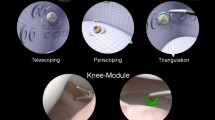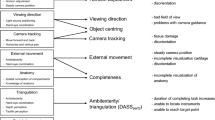Abstract
Purpose
It is reasonable to question whether the case volume is a suitable proxy for the manual competence of an arthroscopic surgeon. The aim of this study was to evaluate the correlation between the number of arthroscopies previously performed and the arthroscopic skills acquired using a standardized simulator test.
Methods
A total of 97 resident and early orthopaedic surgeons who participated in arthroscopic simulator training courses were divided into five groups based on their self-reported number of arthroscopic surgeries: (1) none, (2) < 10, (3) 10 to 19, (4) 20 to 39 and (5) 40 to 100. Arthroscopic manual skills were evaluated with a simulator by means of the diagnostic arthroscopy skill score (DASS) before and after training. Seventy-five points out of 100 must be achieved to pass the test.
Results
In the pretest, only three trainees in group 5 passed the arthroscopic skill test, and all other participants failed. Group 5 (57 ± 17 points; n = 17) scored significantly higher than the other groups (group 1: 30 ± 14, n = 20; group 2: 35 ± 14, n = 24; group 3: 35 ± 18, n = 23; and group 4: 33 ± 17, n = 13). After a two-day simulator training, trainees showed a significant increase in performance. In group 5, participants scored 81 ± 17 points, which was significantly higher than the other groups (group 1: 75 ± 16; group 2: 75 ± 14; group 3: 69 ± 15; and group 4: 73 ± 13). While self-reported arthroscopic procedures were n.s. associated with higher log odds of passing the test (p = 0.423), the points scored in the pretest were found to be a good predictor of whether a trainee would pass the test (p < 0.05). A positive correlation was observed between the points scored in the pretest and the posttest (p < 0.05, r = 0.59, r2 = 0.34).
Conclusions
The number of previously performed arthroscopies is not a reliable indicator of the skills level of orthopaedic residents. A reasonable alternative in the future would be to verify arthroscopic proficiency on the simulator by means of a score as a pass–fail examination.
Level of evidence
III.



Similar content being viewed by others
Data availability
The raw data are available upon request to the corresponding author.
References
Almasri M, Ayeni O (2020) Editorial commentary: defining proficiency in hip arthroscopic surgery is facing its own learning curve. Arthroscopy 36:3106–3107
Alvand A, Auplish S, Khan T, Gill HS, Rees JL (2011) Identifying orthopaedic surgeons of the future: the inability of some medical students to achieve competence in basic arthroscopic tasks despite training: a randomised study. J Bone Jt Surg Br 93:1586–1591
Anetzberger H, Becker R, Eickhoff H, Seibert FJ, Döring B, Haasters F, Mohr M, Reppenhagen S (2022) The diagnostic arthroscopy skill score (DASS): a reliable and suitable assessment tool for arthroscopic skill training. Knee Surg Sports Traumatol Arthrosc 30:349–360
Angelo RL, Ryu RKN, Pedowitz RA, Beach W, Burns J, Dodds J, Field L, Getelman M, Hobgood R, McIntyre L, Gallagher AG (2015) A proficiency-based progression training curriculum coupled with a model simulator results in the acquisition of a superior arthroscopic bankart skill set. Arthroscopy 31:1854–1871
Bartlett JD, Lawrence JE, Khanduja V (2019) Virtual reality hip arthroscopy simulator demonstrates sufficient face validity. Knee Surg Sports Traumatol Arthrosc 27:3162–3167
Bauer H, Honselmann KC (2017) Minimum volume standards in surgery—are we there yet? Visc Med 33:106–116
Baumann Q, Hardy A, Courage O, Lacombes P, Accadbled F (2019) Lessons taught by a knee arthroscopy simulator about participants in a european arthroscopy training programme. Orthop Traumatol Surg Res 105:287–291
Bishop ME, Ode GE, Hurwit DJ, Zmugg S, Rauck RC, Nguyen JT, Ranawat AS (2021) The arthroscopic surgery skill evaluation tool global rating scale is a valid and reliable adjunct measure of performance on a virtual reality simulator for hip arthroscopy. Arthroscopy 37:1856–1866
Boutefnouchet T, Laios T (2016) Transfer of arthroscopic skills from computer simulation training to the operating theatre: a review of evidence from two randomised controlled studies. SICOT-J 2:4. https://doi.org/10.1051/sicotj/2015039
Camp CL, Krych AJ, Stuart MJ, Regnier TD, Mills KM, Turner NS (2016) Improving resident performance in knee arthroscopy: a prospective value assessment of simulators and cadaveric skills laboratories. J Bone Jt Surg Am 98:220–225
Cychosz CC, Tofte JN, Johnson A, Gao Y, Phisitkul P (2018) Fundamentals of arthroscopic surgery training program improves knee arthroscopy simulator performance in arthroscopic trainees. Arthroscopy 34:1543–1549
Erturan G, Alvand A, Judge A, Pollard TCB, Glyn-Jones S, Rees JL (2018) Prior generic arthroscopic volume correlates with hip arthroscopic proficiency: a simulator study. J Bone Jt Surg Am 100(1):e3. https://doi.org/10.2106/JBJS.17.00352
Fahl JT, Duvivier R, Reinke L, Pierie J-PEN, Schönrock-Adema J (2023) Towards best practice in developing motor skills: a systematic review on spacing in VR simulator-based psychomotor training for surgical novices. BMC Med Educ 23:154. https://doi.org/10.1186/s12909-023-04046-1
Feeley AA, Gibbons JP, Feeley IH, Fitzgerald E, Merghani K, Sheehan E (2022) Hand dominance and experience improve bimanual performance on arthroscopic simulator task. Knee Surg Sports Traumatol Arthrosc 30:3328–3333
Feldman MD, Brand JC, Rossi MJ, Lubowitz JH (2017) Arthroscopic training in the 21st century: a changing paradigm. Arthroscopy 33:1913–1915
Gallagher AG, Mottrie A, Angelo RL (2022) Competence is about skill, not procedure case numbers. JAMA Surg 157:81. https://doi.org/10.1001/jamasurg.2021.4414
Gallagher AG, Ritter EM, Champion H, Higgins G, Fried MP, Moses G, Smith CD, Satava RM (2005) Virtual reality simulation for the operating room: proficiency-based training as a paradigm shift in surgical skills training. Ann Surg 241:364–372
Go CC, Kyin C, Maldonado DR, Domb BG (2020) Surgeon experience in hip arthroscopy affects surgical time, complication rate, and reoperation rate: a systematic review on the learning curve. Arthroscopy 36:3092–3105
Harato K, Kobayashi S, Toyoda T, Hasegawa T, Tsukimura Y, Niki Y (2020) Technical obstacles for low-volume surgeons in primary anterior cruciate ligament reconstruction. J Knee Surg 33:1238–1242
Hauschild J, Rivera JC, Johnson AE, Burns TC, Roach CJ (2021) Shoulder arthroscopy simulator training improves surgical procedure performance: a controlled laboratory study. Orthop J Sports Med. https://doi.org/10.1177/23259671211003873
Hopkins L, Robinson DBT, Brown C, Egan R, Iorwerth A, Holt M, Lewis WG (2019) Trauma and orthopedic surgery curriculum concordance: an operative learning curve trajectory perspective. J Surg Educ 76:1569–1578
Hughes JD, Gibbs CM, Almast A, Atte A, Sansone M, Karlsson J, Musahl V (2022) More anatomic tunnel placement for anterior cruciate ligament reconstruction by surgeons with high volume compared to low volume. Knee Surg Sports Traumatol Arthrosc 30:2014–2019
Keyt LK, Jensen AR, O’Driscoll SW, Sanchez-Sotelo J, Morrey ME, Camp CL (2020) Establishing the learning curve for elbow arthroscopy: surgeon and trainee perspectives on number of cases needed and optimal methods for acquiring skill. J Shoulder Elbow Surg 29:e434–e442. https://doi.org/10.1016/j.jse.2020.04.022
Koehler RJ, Goldblatt JP, Maloney MD, Voloshin I, Nicandri GT (2015) Assessing diagnostic arthroscopy performance in the operating room using the arthroscopic surgery skill evaluation tool (ASSET). Arthroscopy 31:2314-2319.e2. https://doi.org/10.1016/j.arthro.2015.06.011
Kohring JM, Bishop MO, Presson AP, Harrast JJ, Marsh JL, Parsons TW, Saltzman CL (2018) Operative experience during orthopaedic residency compared with early practice in the U.S. J Bone Jt Surg Am 100:605–616
Middleton RM, Baldwin MJ, Akhtar K, Alvand A, Rees JL (2016) Which global rating scale? A comparison of the ASSET, BAKSSS, and IGARS for the assessment of simulated arthroscopic skills. J Bone Jt Surg Am 98:75–81
O’Neill PJ, Cosgarea AJ, Freedman JA, Queale WS, McFarland EG (2002) Arthroscopic proficiency: a survey of orthopaedic sports medicine fellowship directors and orthopaedic surgery department chairs. Arthroscopy 18:795–800
Price AJ, Erturan G, Akhtar K, Judge A, Alvand A, Rees JL (2015) Evidence-based surgical training in orthopaedics: how many arthroscopies of the knee are needed to achieve consultant level performance? Bone Jt J 97-B:1309–1315
Rahm S, Germann M, Hingsammer A, Wieser K, Gerber C (2016) Validation of a virtual reality-based simulator for shoulder arthroscopy. Knee Surg Sports Traumatol Arthrosc 24:1730–1737
Rahm S, Wieser K, Bauer DE, Waibel FW, Meyer DC, Gerber C, Fucentese SF (2018) Efficacy of standardized training on a virtual reality simulator to advance knee and shoulder arthroscopic motor skills. BMC Musculoskelet Disord 19:150. https://doi.org/10.1186/s12891-018-2072-0
Raja A, Thomas P, Harrison A, Tompkins M, Braman J (2019) Validation of assessing arthroscopic skill using the ASSET evaluation. J Surg Educ 76:1640–1644
Rashed S, Ahrens PM, Maruthainar N, Garlick N, Saeed MZ (2018) The role of arthroscopic simulation in teaching surgical skills: a systematic review of the literature. JBJS Rev 6:e8. https://doi.org/10.2106/JBJS.RVW.17.00201
Stotts AK, Kohring JM, Presson AP, Millar MM, Harrast JJ, Van Heest AE, Zhang C, Saltzman CL (2019) Perceptions of the recommended resident experience with common orthopaedic procedures: a survey of program directors and early practice surgeons. J Bone Jt Surg Am. https://doi.org/10.2106/JBJS.18.00149
Stunt JJ, Kerkhoffs GMMJ, van Dijk CN, Tuijthof GJM (2015) Validation of the ArthroS virtual reality simulator for arthroscopic skills. Knee Surg Sports Traumatol Arthrosc 23:3436–3442
Tofte JN, Westerlind BO, Martin KD, Guetschow BL, Uribe-Echevarria B, Rungprai C, Phisitkul P (2017) Knee, shoulder, and fundamentals of arthroscopic surgery training: validation of a virtual arthroscopy simulator. Arthroscopy 33:641–646
Vaghela KR, Trockels A, Lee J, Akhtar K (2022) Is the virtual reality fundamentals of arthroscopic surgery training trogram a valid platform for resident arthroscopy training? Clin Orthop Relat Res 480:807–815
Wallenstein MR, Ananth CV, Kim JH, Burke WM, Hershman DL, Lewin SN, Neugut AI, Lu Y-S, Herzog TJ, Wright JD (2012) Effect of surgical volume on outcomes for laparoscopic hysterectomy for benign indications. Obstet Gynecol 119:709–716
Weinheimer KT, Smuin DM, Dhawan A (2017) Patient outcomes as a function of shoulder surgeon volume: a systematic review. Arthroscopy 33:1273–1281
Zhou H, Xian C, Zhang K-J, Yang Z, Li W, Tian J (2022) The frequency of assessment tools in arthroscopic training: a systematic review. Ann Med 54:1646–1656
Funding
No funding was received for this study.
Author information
Authors and Affiliations
Contributions
HA and SR conceived and designed the study. RB and SK revised the manuscript critically for intellectual content. DJ and AK designed the study and collected the data. RB gave the final approval of the manuscript.
Corresponding author
Ethics declarations
Conflict of interest
The authors declare that they have no conflict of interest.
Ethical approval
The current study was approved by the ethical committee of the Bavarian State Chamber of Physicians (BLÄK) (approval number 2022-1210).
Additional information
Publisher's Note
Springer Nature remains neutral with regard to jurisdictional claims in published maps and institutional affiliations.
Rights and permissions
Springer Nature or its licensor (e.g. a society or other partner) holds exclusive rights to this article under a publishing agreement with the author(s) or other rightsholder(s); author self-archiving of the accepted manuscript version of this article is solely governed by the terms of such publishing agreement and applicable law.
About this article
Cite this article
Anetzberger, H., Kugler, A., John, D. et al. The number of arthroscopies performed by trainees does not deduce the level of their arthroscopic proficiency. Knee Surg Sports Traumatol Arthrosc 31, 4231–4238 (2023). https://doi.org/10.1007/s00167-023-07471-3
Received:
Accepted:
Published:
Issue Date:
DOI: https://doi.org/10.1007/s00167-023-07471-3




